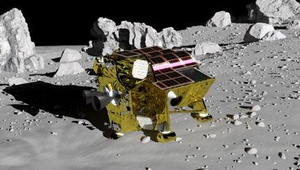New Delhi: Japan has made the most precise ever Moon landing to become the fifth country to successfully land on the Moon after Russia, the US, China and India.
The 2.7-metre Smart Lander for Investigating Moon (SLIM) touched down on the lunar surface at about 10:20 am EST (8.50 pm IST) on January 20. It began its journey to the Moon on September 6 along with XRISM, a powerful X-ray space telescope.
SLIM landed on the slope of Shioli Crater, a relatively fresh, 300-metre-wide impact feature within Mare Nectaris.
According to Japan Aerospace Exploration Agency (JAXA), SLIM achieved a pinpoint landing within 100 metres of the target, as planned.
However, the lander appears to be lying upside-down, and it cannot generate power, said mission officials at the JAXA, who hope the probe will be able to recharge when the moon enters its daytime in the coming days.
“Analysis of the data acquired before shutting down the power confirmed that SLIM had reached the Moon’s surface approximately 55m east of the original target landing site,” the agency said in a statement.
Further, JAXA noted that communication has been established with spacecraft after the landing. However, the solar cells are currently not generating power.
“Analysis of the data has shown that SLIM’s solar cells are currently facing west, suggesting that there is the possibility for power generation and thus recovery of SLIM as the sunlight illumination condition improves with time,” it said.
SLIM, also known as “Moon Sniper” in Japanese, was supposed to land on its side — a strategy to avoid tipping over on the sloped terrain of the landing site. However, just about 150 feet above the ground, one of SLIM’s two main engines appears to have failed, said JAXA.
“At an altitude of 50m just prior to the start of the obstacle avoidance manoeuvre, the thrust from one of the two main engines was most likely lost.”
The soft landing has been a tricky issue as it involves a series of complex manoeuvres consisting of rough and fine braking.
Japan has previously failed in two lunar landing attempts. JAXA lost contact with the OMOTENASHI lander and scrubbed an attempted landing in November, while the Hakuto-R Mission 1 lander, by Japanese startup ispace, crashed in April as it attempted to descend to the lunar surface.
To help the spacecraft spot craters/boulders on the lunar surface, it was armed with a navigation camera.
While descending onto the lunar surface, the “vision-based navigation” enabled it to find the exact location, matching its camera’s images with existing satellite photos of the moon.
The cargo research mission also carries a variety of scientific payloads, including an analysis camera and a pair of lunar rovers LEV-1 and LEV-2, which JAXA said successfully separated just prior to landing. The multi-band spectroscopic camera (MBC) onboard SLIM was also operated on a trial basis and captured images until the power was turned off.
JAXA said that “LEV-1 completed its planned operational period on the lunar surface, depleted its designated power, and is in a standby state”. Further activity may depend on solar power generation from changes in the direction of the sun.
“Both LEV-1 and LEV-2 have become Japan’s first lunar exploration robots. Additionally, the small LEV-1 with a mass of 2.1 kg (including a 90g communication device), achieved successful direct communication with Earth from the moon. This is considered as the world’s smallest and lightest case of direct data transmission from approximately 380,000 kilometres away,” JAXA said.
The lander’s instrument now aims to make detailed measurements of the composition of the rocks and soil on the lunar surface.
“While more detailed evaluation continues, it is reasonable to mention that the technology demonstration of pinpoint landing within an accuracy of 100m, which has been declared to be the main mission of SLIM, has been achieved,” the agency said.
–IANS


Comments are closed.